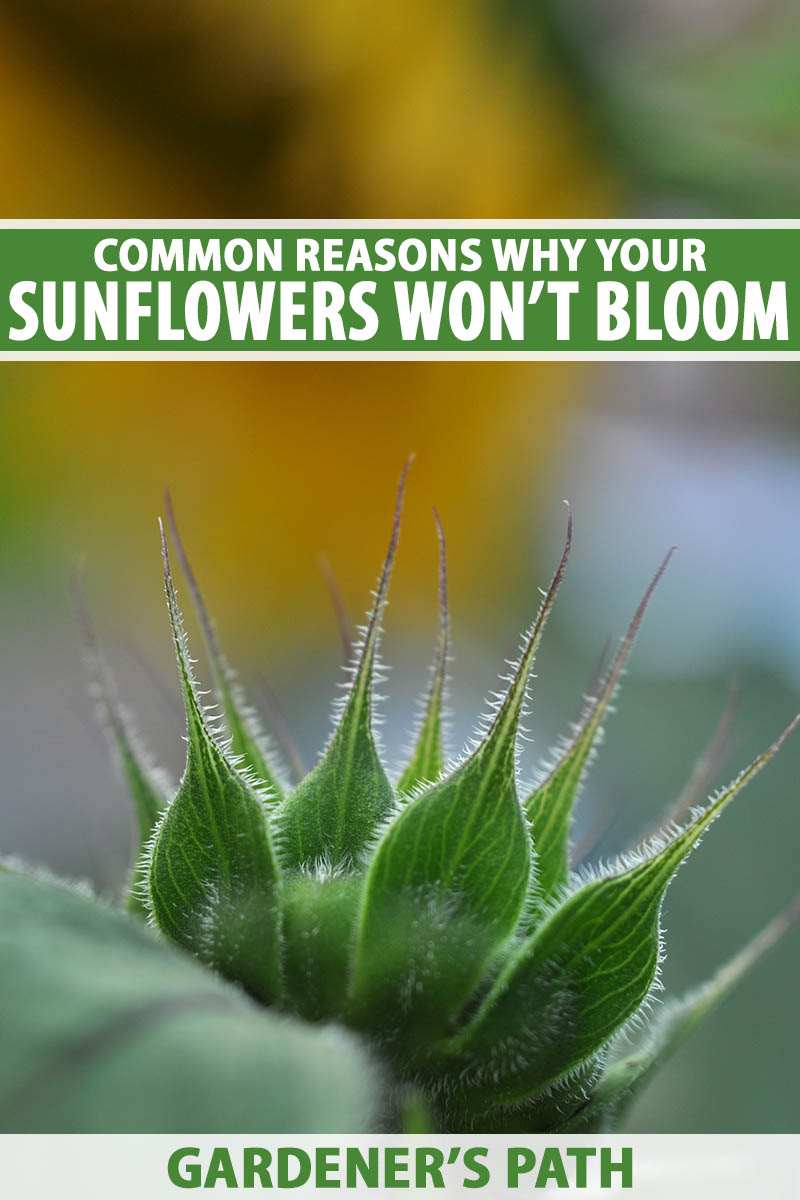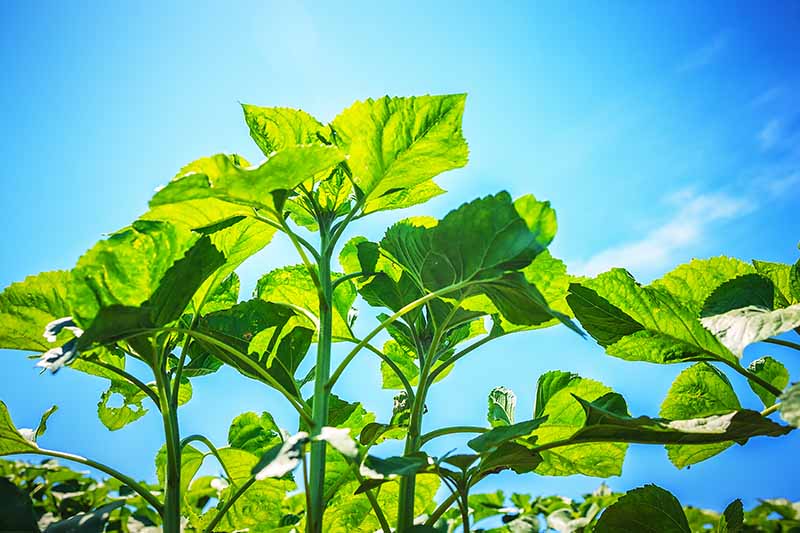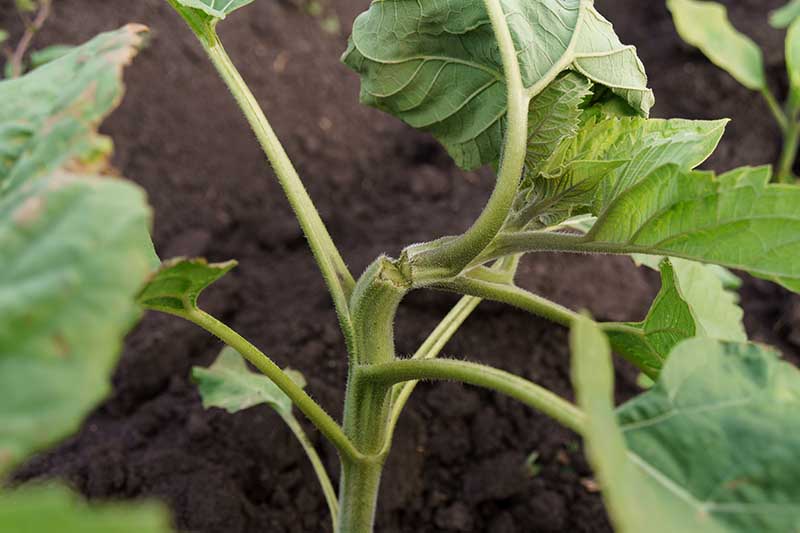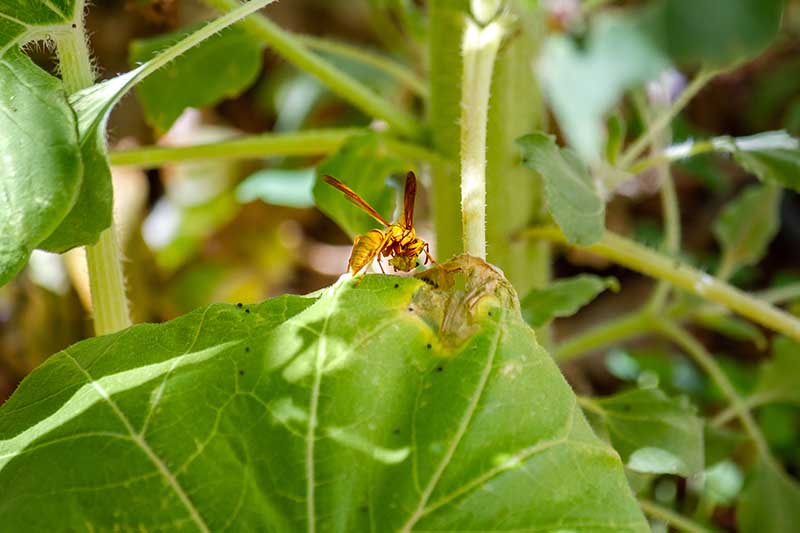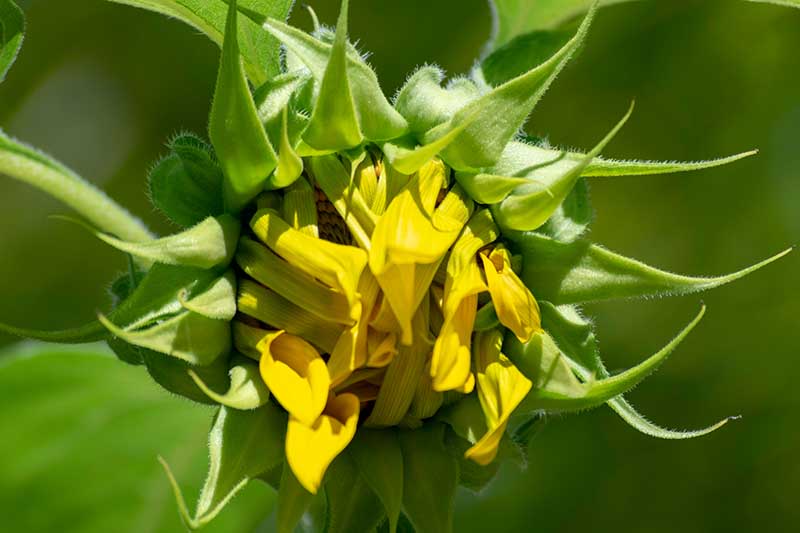Those aren’t the actual words to the song, but that’s how I sing it. Still, I have to admit, that joyous feeling only occurs when they burst into bloom, seeming to smile with their round faces and bright petals. Sunflowers that don’t flower can make a person a little sad. But don’t take it as a bad sign or something personal if your Helianthus annuus won’t bloom. There are perfectly logical reasons why this happens, and I’m going to give you the rundown right now. When there’s a potential solution, I’ll offer it along with the cause. We link to vendors to help you find relevant products. If you buy from one of our links, we may earn a commission. I can tell you from experience, that’s not too awful – and far better than someone taking all your sunflowers away. And while you’re learning why the ones you’re growing aren’t blooming, you’ll also pick up a few tips on keeping all the available varieties healthy and flowering at their best. Here’s what I’ll cover: Sunflowers are so big and bold, it’s pretty easy to determine when they haven’t flowered. But detecting the reason for the no-show blooms can be a bit trickier. I think it’s most helpful to systematically rule out each of the top possibilities, beginning with the simplest. Here are the most common causes when H. annuus doesn’t flower:
1. Not Enough Sun
I’m sure it’s no surprise that a plant called “sunflower” grows best in the sun! You may be able to coax a few to emerge from the ground and attain a few feet of height in garden spots with part shade, sure. But in addition to getting leggy, they’ll have smaller flowers than those grown in full sun. Less than six hours of full sun per day could also result in no blooms at all. Along with selecting a location with ample light, be sure to plant even shorter varieties in spots where larger plants won’t throw shade. Dwarf varieties may be cute and small, but they’re still proper sunflowers and require lots of light. To grow big enough to produce flower heads, larger varieties require lots of sun, and a sheltered location. High winds can cause the tall plants to topple long before they bloom, and once they’re down, they’re typically done. Solution: If you don’t have a plot that offers full sun, consider growing container varieties that you can place somewhere with more sunlight.
2. Too Little Time
If the plants look tall enough and you’ve been watering and weeding and whatnot, you may think, “Bloom time!” But nothing can compensate for the passage of time. Different cultivars reliably bloom only within an established time frame. Some types take a whopping 110 to 120 days to bloom, and if you have planted one of them, there’s no speeding them up. Solution: If you live in an area with a short growing season, you may still be able to coddle the mature plants with row covers or other protection in the chilly season, until they’re able to flower. Don’t count on results, though! In general, you want to determine how long a variety needs to mature and bloom before you plant (or purchase seeds, for that matter). You may be surprised, because even some dwarf varieties might need an excess of 85 days before blooming.
3. Too Much Nitrogen
Applying the right type and correct amount of fertilizer is one of the trickier aspects of growing sunflowers in your garden. ‘Sunspot’ One example is ‘Sunspot,’ which grows just 30 to 36 inches tall and blooms in about 65 days. Seeds are available from True Leaf Market. According to Robin Trott, extension educator at the University of Minnesota Extension, a “side dressing of an all-purpose slow release fertilizer applied when the sunflowers have several true leaves will speed growth and produce larger flowers.” That sounds good, but it’s also important to note that high-nitrogen fertilizers may instead prohibit the formation of healthy flower heads. Indicators that too much nitrogen is the source of your woes include planting in a location where you had nitrogen-fixing plants like legumes growing the year before, and sunflowers with an abundance of extra-large leaves. Solution: If you accidentally applied too much nitrogen or planted seeds in nitrogen-rich soil, this is one of the times when it might be best to start over, or start over next year. Make sure to replant with a fast-growing variety, and only sow seeds in a spot that hasn’t been rigorously fertilized for at least a season or two. If you’re quite attached to the foliage-rich stalks you already have, you may want to attempt root pruning. In a small percentage of cases, this will startle the plants into forming flower heads and blooming. Please realize, this may turn out to be a futile use of muscle and garden tools. But it could be worth a shot. To perform root pruning, set a zone about three inches from the main stalk on all four sides, marking it with a line of sand if that helps you envision your task. Then jab a spade into the soil on those lines, pushing the tool about four inches deep on each side. The effort should sever the outer roots without killing the plant, and may shock it into putting energy into forming flower heads, instead of more leaves.
4. Deer
Deer do get blamed for a lot of garden damage, but hey, they are most often guilty as charged. Sorry to side against these cuties, but they may also be the reason your sunflowers don’t bloom. If they are already garden pests, you can be sure they’ll happily eat the flower heads from the stalks before they get a chance to bloom. And here’s that word “sad” again, but sadly, if you are growing a bigger culinary variety of sunflower, it only produces a single flower head per stalk. If a deer chomps it off, it’s not going to bloom at all.
5. Insect Pests
Sometimes they don’t bloom readily, but these plants that are such favorites among birds and floral arrangers are still plenty tough. ‘Evening Colors’ And to counter the “one and done” issue with single stem sunflowers, try growing a multi-branching variety like ‘Evening Colors’ instead of the types with a lone flower head. Seeds are available from Eden Brothers. They’ll usually still produce flowers even after contracting downy or powdery mildew, for example, or if certain types of bugs prey on their leaves. There are a few insect pests that will keep them from blooming, though. Sunflower moths, Homoeosoma electellum, are one of the most destructive species. The adults have dusky brown wings that they wrap tightly to their bodies when they’re at rest, making them look like mini hot dog buns with antennae. The larvae resemble oversize brown inchworms with white stripes. If you spot webs and dark insect residue on your sunflower heads, the larvae could be feeding on the insides. The older larvae will eat the tissue from the flower heads, and these pests also promote Rhizopus fungi, which rots the flower heads before and during blooming. Yuck! While parasitic wasps, and sometimes parasitic flies, tend to keep the moths at bay on wild plants, that may not happen in a residential garden. Solution: Because pollinators swarm to sunflowers, and they’re often a source of food for humans as well as wildlife, letting nature take its course is often the best way to handle the moths. This is easier to accept when you realize the moths tend to appear only sporadically, not every season or even on every plant. I heed the advice of North Carolina State Extension entomology and plant pathology professor emeritus James Baker: “If the sunflower moth caterpillars have gotten ahead of these natural controls, I recommend destroying the infested heads by freezing, burying, or wrapping tightly and sending them to the dump to avoid damaging pollinators.” Be sure to dispose of infested plant waste in the trash in a sealed bag, not in the compost pile. Baker goes on to say, “Sunflowers and other composites attract native bees, some of which are relatively rare and which would be on the endangered species lists if we knew enough about the bees to add them.” If you feel you must spray – and I wouldn’t – Baker advises only spraying up until flower buds open, or waiting until after pollinators are likely to seek out the blooms. Sunflower midges, Contarinia schulzi, will also lay their eggs rudely in the flower heads. When the larvae hatch, they feed on the tiny bracts below the flower head, leaving that part of the plant brown and scarred. They also eat the developing seeds within the flower heads. Midge handiwork will promote knotted, misshapen flower head development or keep the buds from blooming – not what you want at all! Midges don’t usually take out a whole lot of flowers, which is good, since you can’t combat them with insecticides – they’re out of reach from sprays within the flower heads. Solution: If you’ve had midge trouble in the past, you will want to avoid planting sunflowers in that same area for several seasons. Also seek out hybrid varieties that are described as being resistant to or tolerant of midges. Are you a fellow fan? If so, your input on how to keep them blooming is more than welcome in the comments section below. That’s the place to ask questions and share photos, too. Then, to get more ideas for selecting and caring for sunflowers in your garden, check out these guides next:
How to Grow Sunflowers: a Beautiful and Tasty Addition to Your LandscapeSolutions for Sunflowers That Droop9 Popular Pollenless Sunflowers to Grow in Your GardenHow to Protect Sunflowers from Birds and Squirrels
